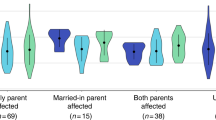Summary
Currently it is not clear whether minor forms of unipolar depression not matching the criteria of “major depression” should be considered as a separate diagnostic category. A controlled family study examined the familial aggregation of minor depression among probands with unipolar major depression. In the families of these probands the relative risk for minor depression was elevated by a similar magnitude to the risk for major depression. Threrefore, the diagnostic category “minor depression” would not increase diagnostic sensitivity at the expense of diagnostic specificity as far as familiality is the criterion. In agreement with recent epidemiological studies, minor depression did not reveal a similar excess prevalence in females compared with males as major depression does. The variation of the sex ratio for any subtype of unipolar depression was not associated with the familiality of this disorder.
Similar content being viewed by others
References
American Psychiatric Association (1980) Diagnostic and Statistical Manual of Mental Disorders. Third Edition. American Psychiatric Association, Washington, DC
American Pschiatric Association (1987) Diagnostic and Statistical Manual of Mental Disorders. Third Edition, Revised. American Psychiatric Association, Washington, DC
Andreasen NC, Rise J, Endicott J, Reich T, Coryell W (1986) The family history approach to diagnosis. How useful is it? Arch Gen Psychiatry 43:421–429
Andreasen NC, Rice J, Endicott J, Coryell W, Grove WM, Reich T (1987) Familial rates of affective disorder. A report from the National Institute of Mental Health Collaborative Study. Arch Gen Psychiatry 44:461–469
Angst J, Dobler-Mikola A (1984) Do the diagnostic criteria determine the sex ratio in depression? J Affective Disord 7:189–198
Barrett JE, Barrett JA, Oxman TE (1988) The prevalence of psychiatric disorders in a primary care practice. Arch Gen Psychiatry 45:1100–1106
Endicott J, Nee J, Andreasen N, Clayton P, Keller M, Coryell W (1985) Bipolar II. Combine or keep separate? J Affective Disord 8:17–28
Ernst C, Angst J (1992) The Zurich study. XII. Sex differences in depression. Evidence from longitudinal epidemiological data. Eur Arch Psychiatry Clin Neurosci 241:222–230
Gershon ES, Hamovit J, Guroff JJ, Dibble E, Leckman JF, Sceery W, Targum SD, Nurnberger JI Jr, Goldin LR, Bunney WE (1982) A family study of schizoaffective, bipolar I, bipolar II, unipolar, and normal control probands. Arch Gen Psychiatry 39:1157–1167
Kessler LG, Cleary PD, Burke JD (1985) Psychiatric disorders in primary care. Results of a follow-up study. Arch Gen Psychiatry 42:583–587
Lee ET (1980) Statistical methods for survival data analysis. Lifetime Learning Publication, California
Maier W, Hallmayer J, Lichtermann D, Philipp M, Klingler T (1991) The impact of the endogeneous subtype on the familial aggregation of unipolar depression. Eur Arch Psychiatry Clin Neurosci 240:355–362
Spitzer RL, Endicott J, Robins E (1978) Research diagnostic criteria: rationale and reliability. Arch Gen Psychiatry 35:773–783
Weissman MM, Kidd KK, Prusoff BA (1982) Variability in rates of affective disorders in relatives of depressed and normal probands. Arch Gen Psychiatry 39:1397–1403
Young MA, Fogg LF, Scheftner WA, Keller MB, Fawcett JA (1990) Sex differences in the lifetime prevalence of depression: does varying the diagnostic criteria reduce the female/male ratio? J Affective Disord 18:187–192
Author information
Authors and Affiliations
Rights and permissions
About this article
Cite this article
Maier, W., Lichtermann, D., Minges, J. et al. The risk of minor depression in families of probands with major depression: Sex differences and familiality. Eur Arch Psychiatry Clin Nuerosci 242, 89–92 (1992). https://doi.org/10.1007/BF02191553
Received:
Issue Date:
DOI: https://doi.org/10.1007/BF02191553




